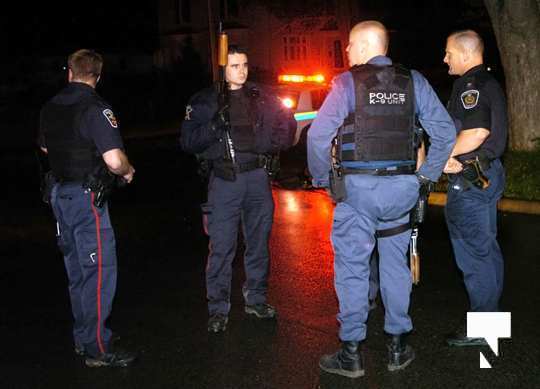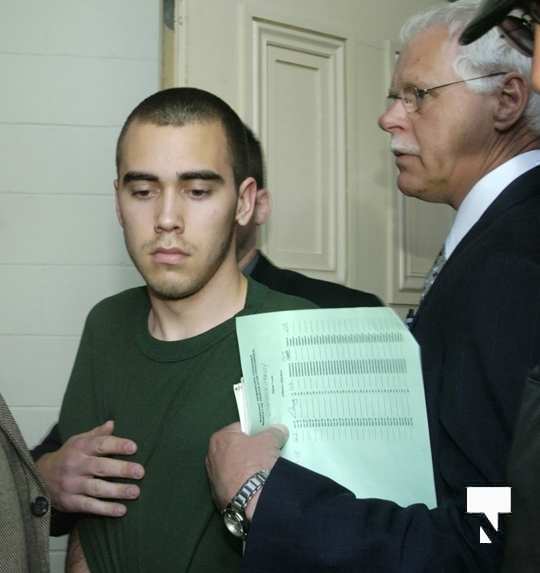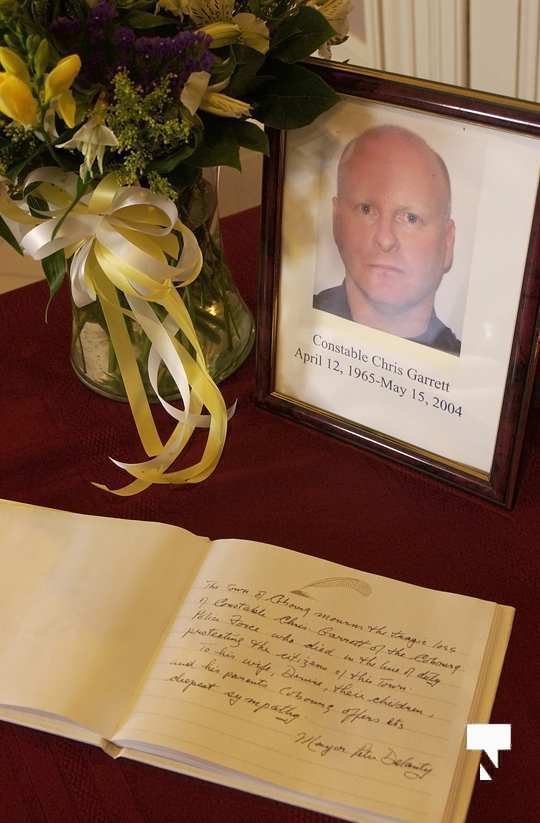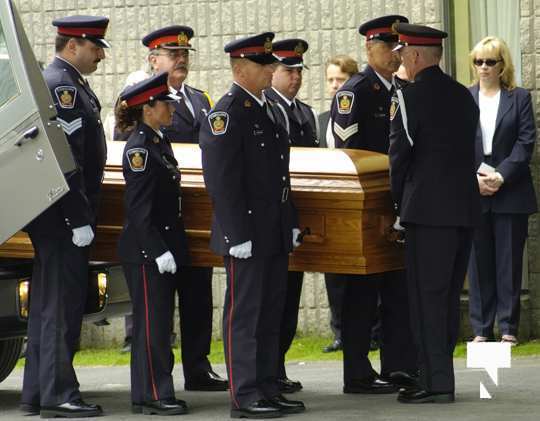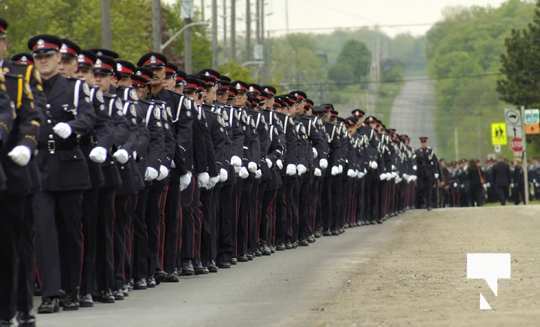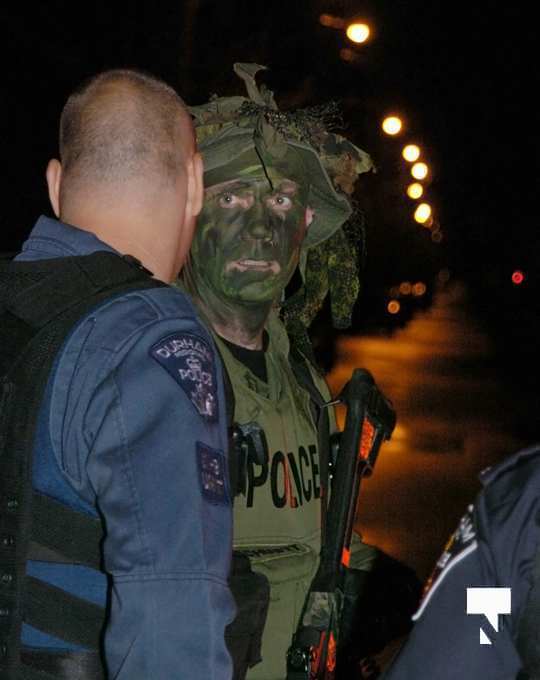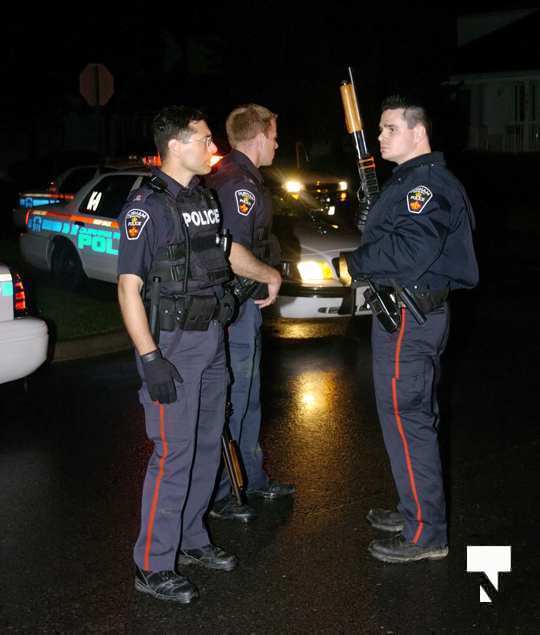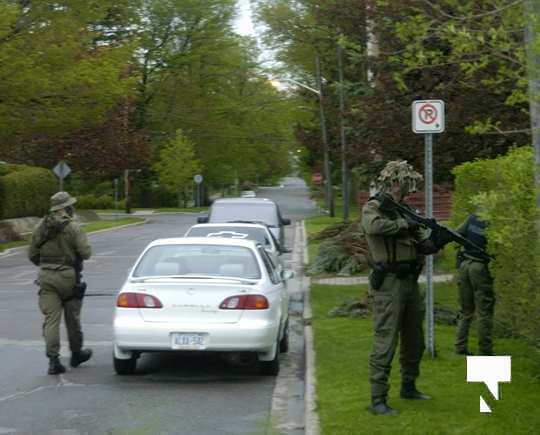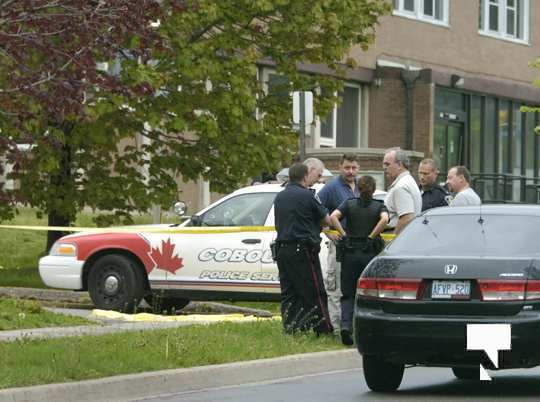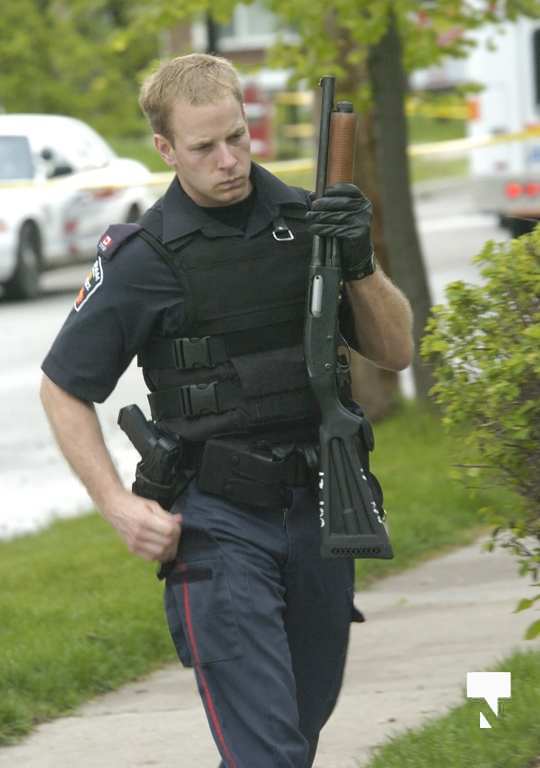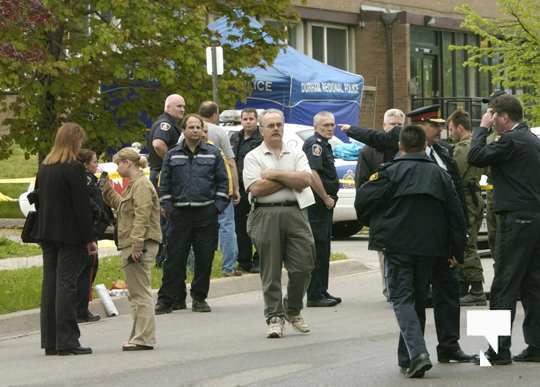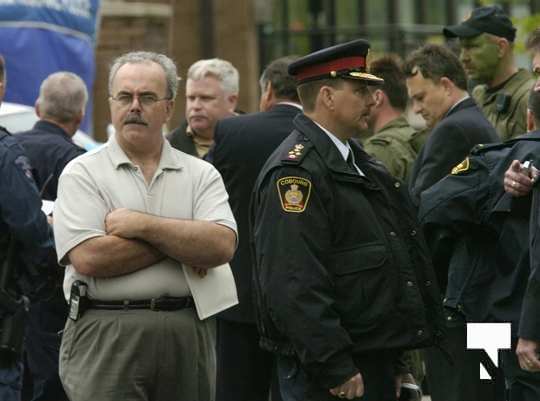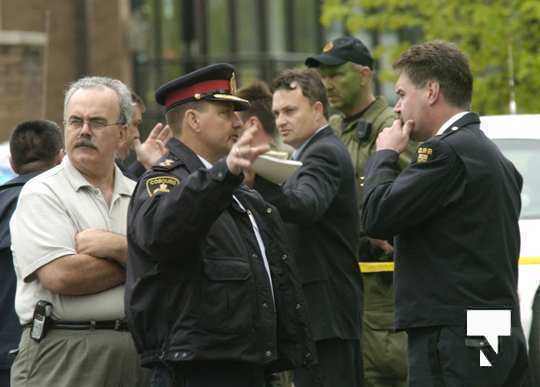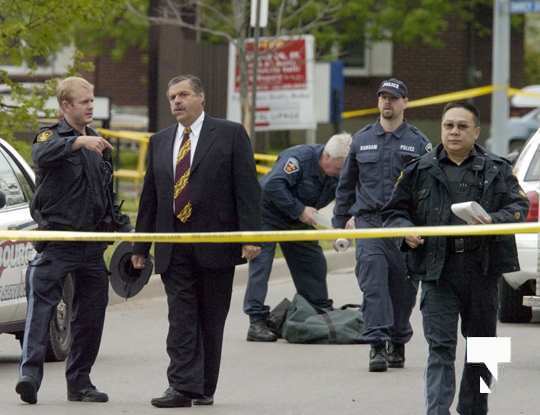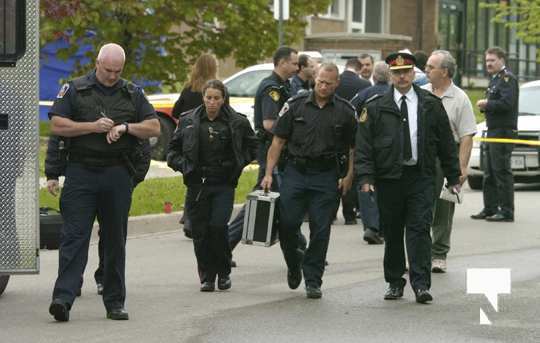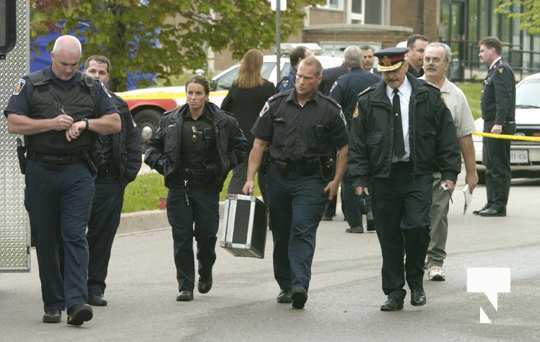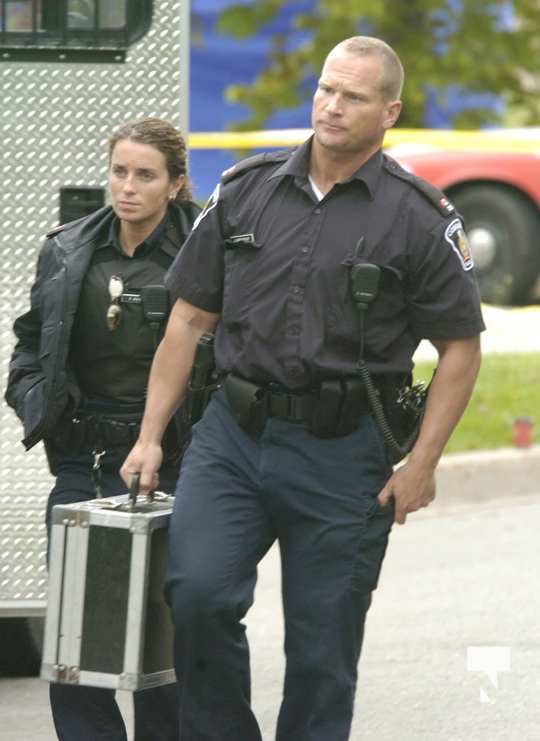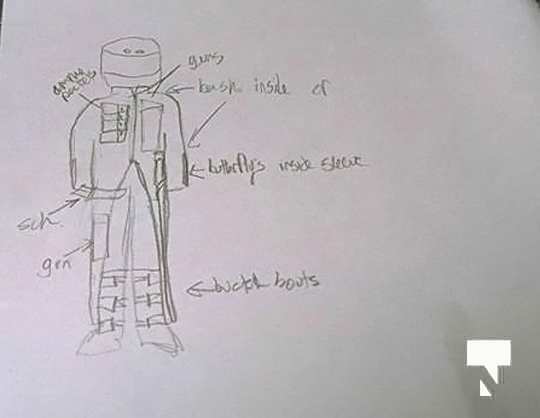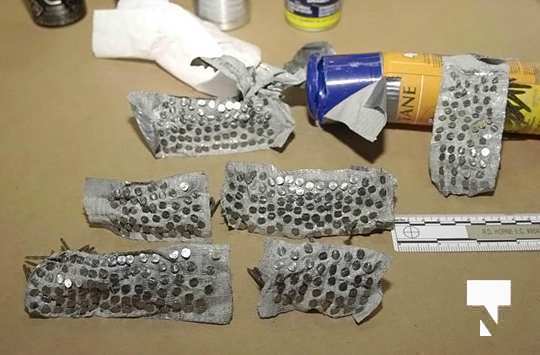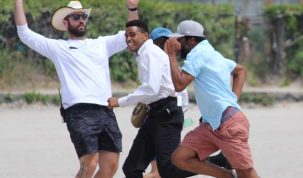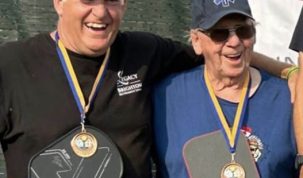A cold blooded cop killer had his chance for early release turned down in a decision released on Friday, July 10, 2020 in a written decision in Superior Court of Justice in Cobourg.
Troy Davey was 18-years-old at the time he murdered 38-year-old Cobourg Police Constable Chris Garrett on the property of the former hospital in the early hours of May 15, 2004.
Today’s Northumberland has a copy of the 18-page decision by Justice Jocelyn Speyer.
The Superior Court of Justice was presented with the judicial screening of an application under the faint hope clause.
Essentially the faint hope clause provides offenders convicted of murder or high treason who are serving a sentence of life without eligibility of parole until more than 15-years a chance for early parole.
Davey was represented by J. Presser and J. Marshman while Russell Wood was Crown Attorney.
There are six sections of the 18 page decision by Justice Speyer.
· Introduction
· The Screening Standard
· What Is A Reasonable Prospect of Success?
· The Factors To Be Considered?
· The Application of the Test
· Conclusion
Today’s Northumberland will endeavour to explain the decision in detail.
All information contained below is directly from the decision by Justice Speyer.
Troy Davey killed Constable Christopher Garrett of the Cobourg Police Service by slashing his throat.
Davey is now 35-years-old and has served 16-years in prison.
At the time of his murder, Garrett left behind a son, his parents and three sisters.
Davey was convicted by a jury on February 22, 2007 of first degree murder and having possession of an explosive substance with intent to endanger life. He was sentenced to the mandatory sentence of life imprisonment without elibibility for parole for 25-years. His full parole eligibility date is May 15, 2029. His conviction was upheld by the Ontario Court of Appeal and by the Supreme Court of Canada.
Davey has served 15-years of his sentence and was able to apply for the Criminal Code for a “faint hope” hearing for the purpose of seeking a reduction in the number of years that he must serve before he is eligible for parole.
The decision states that Davey does not have an automatic right to a hearing before a jury. Applications must be screened by a judge before a jury hearing is granted.
The submitted material from the Crown and Davey’s counsel includes “extensive” materials including trial transcripts, psychiatric and psychological reports, victim impact statement and records of the Correctional Service of Canada.
“I have concluded the application must be dismissed,” states Justice Speyer.
“The applicant (Davey) does not, and never has, taken full responsibility for his actions.”
Speyer said, “the test prescribed by the Criminal Code was whether there would be a “reasonable prospect” the application would proceed before a unanimous jury.
The factors that must be considered on the application are as follows:
(a) the character of the applicant (Davey)
(b) the applicant’s (Davey) conduct while serving the sentence
(c) the nature of the offence for which the applicant was convicted
(d) any information provided by a victim at the time of the imposition of the sentence or at the time of the hearing under this section; and
(e) any other matters that the judge considers relevant in the circumstances
In order to reduce the period of ineligibility, the applicant must satisfy all 12 jurors.
“Accordingly, the test at the judicial screening stage is whether on the material filed the applicant (Davey) satisfies the judge on a balance of probabilities that there is a reasonable prospect that a jury would unanimously reduce the ineligibility period.”
“The mandated sentence for first degree murder is life imprisonment without parole eligibility for 25 years. The applicant (Davey) must show that his current situation justifies a departure from the normal legislated sentence.”
Below is The Application to the Test
A warning at times it is graphic.
It is written verbatim by Justice Speyer
The application of the test
All murders are odious. Murder involves the intentional taking of a human life and is a cruel and reprehensible act. A sentence of life imprisonment, with no eligibility for parole for 25-years, is mandatory for an offender convicted of first-degree murder.
The murder committed by the applicant, the intentional and brutal killing of an on-duty police officer, was an abhorrent act that devastated the victim’s family and community.
The applicant (Davey) and Constable Garrett of the Cobourg Police Service were unknown to each other before the early morning hours of Saturday, May, 15, 2004.
They met in the parking lot of the abandoned old Cobourg hospital, because the applicant (Davey) lured Constable Garrett there as part of elaborate plan he had developed during the preceding five days.
During the week before the murder, the then 18-year-old applicant (Davey) developed a plan to kill at least one police officer and perhaps other people. The plan was created on the applicant’s (Davey) computer on Monday, May 14, 2004. It was accessed daily after its creation. it provided as follows:
Series of events
Prank call 4:37 a.m. Monday morning
Police arrive 10-25 minutes later
“Punk kiffed my wallet:
Take out officer(s)
Take off equipment
Pick up your own stuff
Drive police cruiser to car dealership park out back
Suit up
Smash into car let take Jetta
Drive to Bruce and Ricks cap cashier unless there’s only one fill up take snacks rob
Take out cashier fill up on gas and food light gas station on fire as distraction
Down to second car dealership
Hide Jetta in lot
Take car whenever it opens knife dealer
Take car back to house to pick up bomb bagsHead to police station. Slash tires
Butane bomb out back
Napalm exits & gas can fire route then wait till officers come out hit butane bomb
Drive to bank park side o Scotia more napalm in streets on buildings
Rob bank
Hit up crappy tire make stand
If still living hit up the mall (take laptop)
Make escape on back roads
Items needed in chrono order
Cell phone
Backpacks all
Quickdry cement
Car jack
Napalm Molotov cocktails
On Tuesday, May 11, 2004, the applicant (Davey) accessed websites for several police services, including the Cobourg Police Service. On that day, he also created a document headed “shopping list,” which listed:
Mix
Soap and gas
Gas and Styrofoam
Chaos is coming…chaos is here…chaos has made everyone leave the building.
Soap, gas, and styrofoam were later used by him to make napalm.
The next day, the applicant (Davey) accessed a webiste that described how to make napalm and bombs. He also went to a hardware store and bought supplies to make explosive devices.
On Thursday, May 13, 2004, he spent more time on the website that informed him how to build explosive devices. He then went to his mother’s home, where he stayed the night. She did not notice anything unusual about him. While there, he took his stepfather’s shotgun, took it apart and concealed it in his bag with his clothing.
On Friday, May 14, 2004, the applicant (Davey) asked his mother to drive him to the Canadian Tire store, where he bought supplies necessary to put his plan into action. She then dropped him off at his father’s home. After reviewing related websites, he made napalm and placed it in glass bottles. This process took time and involved boiling gasoline. He also made an explosive device, punching hundreds of nails through duct tape to do so.
Also, during this week, the applicant (Davey) acquired another shotgun that belonged to his father, and sawed off the barrel. He acquired three knives and loaded both shotguns.
The applicant (Davey) composed a message and saved it on his computer screen that read:
“To all my friends and family, I’m sorry. This will effect (sic) you more than it will ever effect (sic) me. Nothing you have done caused this and there was nothing you could have done to prevent this. Goodbye.”
The creation of this image was the last task performed on that computer.
Also found in his bedroom was a paper on which he had written: “With you I leave my last shred of hope for life, you seem to need it more than I; Its been hell…I hope I take your misery (sic) with me for I am safe within it…Fairwell (sic) dear mother you were all I ever needed but I wanted something less…life sucks. Live with it…I am truly sorry that I became your son, you deserved better.”
The applicant (Davey) left his home and went to the parking lot of the abandoned Cobourg hospital, leaving items related to his plan in his bedroom, including the bottles of napalm and the improvised explosive device.
In so doing, he was acting in accordance with his plan, which was to return to his home to pick up the “bomb bags” after he stole a car.
At 3:02 a.m., the applicant (Davey) called 911 and told the police dispatcher that he had been robbed of his wallet and ring. He provided the dispatcher with a description of the robber and provided his own home address. Officer Garrett was the first officer to arrive, followed by other officers and a security guard from the hospital. The applicant (Davey) provided details of the fictitious robbery. The other officers left in search of the robber and the security guard returned to the hospital.
At 3:15 a.m., Officer Garrett made an announcement over the police radio giving further details of the alleged assailant. By 3:20 a.m. he no longer responded to radio communications.
The applicant (Davey) had slit the officer’s throat in one single motion.
The wound was 25.7 centimetres long and six to seven centimetres deep and was the result of a single slashing or cutting motion, from left to right, inflicted while the applicant was standing behind and to the right of the victim, with the victim’s chin being slightly elevated.
Constable Garrett had no defensive or other wounds.
Constable Garrett discharged his firearm before he died and one bullet hit the applicant in the leg as he attempted to run away.
The jury unanimously concluded that the applicant (Davey) either intended to kill Constable Garrett or intended to cause him bodily harm that he knew was likely to cause death and was reckless as to whether death ensued or not.
The defence, which was that Davey did not intend to kill Constable Garrett, was rejected by the jury.
The applicant (Davey) returned to Constable Garrett as he died and removed his duty belt and firearm by cutting the belt loops of his uniform trousers. He also retrieved the sawed-off shotgun from his backpack that he had hidden before the attendance of the police and tried to get into the police cruiser, but it was locked. He then fled on foot.
It appears the applicant (Davey) followed the first five steps of his plan and was unable to proceed further because he was shot, and because he was unable to take Constable Garrett’s police cruiser.
Sometime before 4:00 a.m., the applicant (Davey) called his mother and asked her to pick him up at his school, which was a short distance from the hospital. She found him, briefly took him home and then to the hospital.
He told her that he had been shot, that he had stabbed a police officer, and that he needed to turn himself in.
She described his appearance as “glazed over” and “staring into space.” On the way to the hospital, at 4:46 a.m., Davey called 911 and said he was on the way to the hospital and was going to turn himself in.
The applicant (Davey) was arrested at the hospital, where he was being treated for the gunshot wound to his right lower leg. the doctor who treated him described his demeanour as very calm.
She noted no signs of alcohol or drug consumption. He seemed lucid and oriented, with no signs of psychosis. His affect was flat.
When he was arrested, he asked the arresting officer “Who was it that I killed?” and “Did he have any family?”
He was co-operative and three days later gave a videotaped statement to police.
The police found knives, a hacksaw and file, Molotov cocktails, a loaded shotgun under a mattress, and a butane aerosol bomb with nails in a backpack in the applicant’s bedroom at his father’s house.
The applicant (Davey) did not testify at trial.
His actions were explained by a psychologist and psychiatrists who relied significantly on hearsay information provided by the applicant (Davey) and his parents.
The evidence of the mental health experts who testified for the defence was, at least in relation to the applicant’s (Davey’s) intention to kill, rejected by the jury. The jury unanimously decided that the applicant (Davey) intended to kill Constable Garrett.
Those experts also provided a great deal of evidence about the applicant’s (Davey’s) motivation and mental health.
Character at the time of the offence
The applicant (Davey) was born on June 7, 1985 and raised in Cobourg, Ontario. He was only 18-years-old when he killed Constable Garrett and his character was not then fully developed. He has never lived independently.
The applicant (Davey) has no criminal record, except for the offences that are the subject of this application.
The offences for which the applicant (Davey) was convicted provide cogent information about his character in May 2004.
He planned and embarked on a course of destruction that included luring the unsuspecting victim to an ambush.
His actions were entirely self-centred and devoid of empathy.
The way he killed Constable Garrett involved the application of direct, decisive and lethal force to the most vulnerable area of the unsuspecting officer. It is difficult to imagine a colder and more calculated murder.
Dr. Chamberlain testified at trial that the applicant (Davey) was a profoundly disturbed young man. He suffered from depression, feeling worthless and that life had no future for him and that he was insignificant.
He also was unable to feel and had very little affect. He developed a belief that the world was meaningless and that other people did not understand how meaningless the world is that was almost narcissistic in form.
He had a violent fantasy life but was emotionally empty.
He wanted to die, could not kill himself, and wanted to die in a sufficiently public way that people would understand that life had no meaning at all. The applicant (Davey) described to Dr. Chamberlain “a Dramatic display that would convince people that the world was meaningless, and that life was meaningless.”
He wanted to get everybody’s attention.
Mr. Davey provided similar information Dr. Ramshaw, a psychiatrist retained by the Crown. While Dr. Ramshaw did not testify at trial, her report was filed on this application. The applicant (Davey) told Dr. Ramshaw that he was depressed and angry in the weeks before the offences. He wanted to attain control over his life and his destiny but did not want to “go out like everyone else.”
He wanted attention and he wanted to be remembered. He then thought of attacking police, causing them to kill him.
Dr. Alan Leschied, a psychologist, testified at the trial. His report is contained in the applicant’s (Davey’s) Correctional Service of Canada psychology file. His testing revealed that the applicant (Davey) is highly intelligent.
The testing also revealed that Mr. Davey experienced intense periodic feelings of anger, which he suppressed. The testing revealed concerns related to depression, preoccupation with suicidality, sleeplessness, and separation anxiety.
Mr. Davey’s personality traits reflected a young person with a long-standing self-defeating and depressive personality with negativistic and schizoid features. Mr. Davey had not experienced past trauma that may have influenced his situation.
On a risk assessment test, Mr. Davey’s profile reflected a low risk to be involved in criminogenic behaviour.
The significance of the risk assessment is diminished by Dr. Leschied’s opinion that if the risk assessment test had been administered in the fall of 2003, the test results would have predicted that Mr. Davey would not commit any crime, let alone a serious crime. There was no diagnosis of antisocial personality disorder or psychopathy.
The applicant’s (Davey’s) parents testified at trial about difficulties he experienced with his family and in school. However, in an interview with Dr. D. Anderson in 2018, the applicant (Davey) stated that he does not believe that childhood trauma or issues motivated his offences, a view supported by Dr. Leschied’s 2007 opinion.
At his trial, the applicant’s (Davey’s) mother testified that things seemed to change for him when he entered high school. In about Grade 10, Mr. Davey began to question the meaning of religion, the relevance of education and his status in his peer group. He became unmotivated. He did not attend classes. He had to repeat Grade 12, and his friends moved on to college and university. He attended for counselling but did not follow through with recommendations. She felt that he spent to much time on his computer.
Before he was sentenced, the applicant (Davey) expressed remorse in a writing provided to his counsel, which stated; “Even if words were capable of expressing my misery of the hurt I’ve caused to so many and the wrongs I have done I feel at this juncture such words would be insulting in their inadequacy but I am truly sorry.”
Character at Present
Following his conviction and sentence, Mr. Davey was transferred from provincial custody to the Millhaven Assessment Unit on March 16, 2007. He was transferred to Kingston Penitentiary on July 4, 2007.
He was then transferred to Millhaven Institution on September 17, 2013 when Kingston Penitentiary closed.
He was transferred to medium security Beaver Creek Institution on December 2, 2014.
He remains there and has never been in a minimum security institution.
A Psychological Risk Assessment of Mr. Davey was conducted by Dr. R. Yokubynas on November 6, 2007, after Mr. Davey was admitted to the penitentiary.
The purpose of the assessment was to assess Mr. Davey’s level of psychological functioning, to review the factors that contributed to his criminal behaviour, to present statistical estimates concerning the probability of both general and violent recidivism, and to offer recommendations on how to mange his risk of recidivism.
Dr. Yokubynas found Mr. Davey to have high average cognitive abilities.
He was pleasant and co-operative and had some insight into the nature of his offence.
There was no evidence of any thought disorder, unusual behaviour or psychosis.
There was no indication of any adherence to criminal sentiments or values. Various actuarial risk assessment tools supported the conclusion that he presents a low risk to re-offend violently or generally.
Every risk assessment conducted since then has concluded that Mr. Davey presents a low risk for both violent and general recidivism.
Mental health professionals who have assessed Mr. Davey during his time in custody agree that his criminal profile is very unusual, and that he does not have the type of risk factors that are typical in the offender population.
I do not find the results of the various risk assessments to be much assistance in the circumstances of this case, because the risk assessment tools would not have predicted Mr. Davey’s murderous actions, and similarly are of limited value in assessing his present character.
The applicant does not, and never has, taken full responsibility for his actions.”
Since his arrest, the applicant has maintained that his offence was centered around the idea of the police killing him. Mr. Davey has continued, throughout his incarceration, to advise CSC staff, including mental health professionals, that his crimes occurred in the context of his idea to commit “suicide by cop,” due to his serious depressive state.
He has told staff that the death of the officer was in response to his panic when he realized that he no longer wanted to go through with the plan and he did not know how to extricate himself from the situation he had created.
When the officer said that they would continue the questioning at the police station, the applicant (Davey) panicked and struck the officer in the throat with the knife he was carrying. This account is at variance with the evidence as to how he killed Constable Garrett and the things he did after officer Garrett died to pursue his plan, such as removing the officer’s equipment belt and attempting to enter the police cruiser. He has repeatedly and consistently told staff that he never intended to kill anyone, and that his goal was to kill himself. This is consistent with the position he took with the experts who examined him prior to his trial. This account is inconsistent with the jury’s verdict.
Mr. Davey has always been willing to engage with mental health staff while serving his sentence. Some of these contacts occurred when risk assessments were required to permit assessment of Mr. Davey’s suitability for programs or transfers. Others were of a therapeutic nature. The focus of those interactions has been to monitor and address any indication that Mr. avey may be developing depressive symptoms.
Mental health professionals assessed Mr. Davey’s mood often.
All reports indicate that he has not experienced any recurrence of depression during his incarceration.
Indeed, he has seldom presented to institutional mental health professionals with any mental health needs.
He did seek assistance with some depressive symptoms when he felt frustrated by his inability to gain a transfer to a medium security institution.
Generally, throughout his sentence, Mr. Davey has reported no psychological problems or mental instability. In his dealings with those professionals, Mr. Davey has presented as stable and calm, and has denied any current thoughts of self-harm.
Mr. Davey has always been willing to engage with mental health staff while serving his sentence. Some of these contacts occurred when risk assessments were required to permit assessment of Mr. Davey’s suitability for programs or transfers.
Others were of a therapeutic nature.
The focus of those interactions has been to monitor and address any indication that Mr. Davey may be developing depressive symptoms.
Mental health professionals assessed Mr. Davey’s mood often. All reports indicate that he has not experienced any recurrence of depression during his incarceration. Indeed, he has seldom presented to institutional mental health professionals with any mental health needs.
He did seek assistance with some depressive symptoms when he felt frustrated by his inability to gain a transfer to a medium security institution.
Generally, throughout his sentence, Mr. Davey has reported no psychological problems or mental instability. In his dealings with those professionals, Mr. Davey has presented as stable and calm, and has denied any current thoughts of self-harm.
Mr. Davey has sought to educate himself about mental health and depression.
In 2013, he advised mental health staff that he tries to engage in healthier behaviour in response to stress or negative emotions, such as distracting himself by listening to music, exercising or talking to his family, or that he would reason himself out of the negative mood, and that he would speak with mental health staff if he felt himself slipping back into a depressed state. He has researched cognitive, emotional and neurological aspects of depression, and in 2015, Counsellor J. Salmn noted that he did an impressive job of educating himself about the subject. He developed coping strategies to employ if his mood decline in the future.
While at Millhaven Institution, in 2014, Mr. Davey completed the Moderate Intensity Violence Prevention Program.
Mr. Davey was gainfully employed untol 2017. From February 2009 until the end of 2009 he worked in the canteen, where he was an excellent worker who demonstrated initiative and worked well with others.
He sought a change in employment because he was frustrated that other inmates tried to take advantage of his position.
He obtained a new position as a cleaner.
In 2011 he quit a job as a cleaner that he performed well for about two years due to pressure from other inmates.
Before then he was assessed to be an excellent worker, who was consistently punctual and prepared and who worked well with staff.
In an application for employment made then, he noted that he wanted to complete his Grade 12. He was accepted to a part-time placement in the school in October 2011. In 2012, he quit a job in “SIS” because he did not want the position and was “applying for cell studies.”
He was approved to engage in post-secondary cell studies commencing September 24, 2012.
While at Millhaven Institution, Mr. Davey was employed or participating in the Violence Prevention Program, which was a full-time course.
In 2014, following his transfer to Beaver Creek Institution, Mr. Davey worked at Corcan, and his performance there was assessed as excellent.
In 2015, he successfully completed courses related to workplace safety.
The applicant (Davey) has been unemployed since May 26, 2017, when he quit his job at Corcan, and he has not looked for work since then.
While inmates are not required to work, those who choose not to work and not to apply for employment receive only a minimal allowance, rather than remuneration for their work.
His stated reason for quitting is that he had finished all programs recommended by his correctional plan, and felt that he was not making progress, so he lacked motivation to continue working.
He says that he quit his job because he felt that he was not helping himself by working, and that he did not see that employment was related to risk and has not been identified as an issue contributing to risk.
He observed that his correctional plan has no clear goals identified.
He stated in 2018 that when he learned that his correctional plan had no criteria related to job retention or work performance, he concluded that work had no impact on his security level or reintegration potential, and therefore there was no reason for him to continue working.
The applicant is presently in a medium security institution.
He has never been transferred to a minimum-security prison.
This is so even though in 2018 Dr. Anderson noted that “there is no contraindication, from a risk management perspective or in consideration of psychological stability, to moving on to the next step in the reintegration process (ie. Transfer to a medium-security setting.)
The reason for this is not clear from the materials provided. Nevertheless, it is apparent that the Correctional Service of Canada views the applicant (Davey) as presently unsuitable for transfer to a minimum-security institution.
The applicant’s (Davey’s) security classification has been a source of frustration for him.
In 2014, when he was in Millhaven Institution, he sought out counselling to address his frustration that he had not been transferred to a medium security institution, even though his transfer was supported by his parole officer and his psychological risk assessment showed no contraindications to his re-classification.
On March 22, 2018, Mr. Davey requested a psychology appointment at Beaver Creek, stating that “I am feeling abnormally frustrated due to a variety of circumstances. May I please meet with someone in order to determine if my feelings are in fact valid and proportional? I would emphasize that this is not an urgent matter.”
He was seen on April 20, 2018, to triage his needs and determine what mental health intervention would be appropriate. He was described, as in most reports, as lucid, polite, cooperative, in good hygiene, future-oriented, and forthcoming with information. His state of mind had improved, and he no longer had any concerns about his mental health. He related that his frustration related to difficulties he was encountering in achieving a re-classification of his security status to minimum. He told the clinician that he attributes his index offence almost exclusively to his mental health status at that time.
The extent to which the applicant is remorseful is part of his character. Genuine remorse can exist only when a person accepts responsibility for his actions. In 2007, prior to his trial, the applicant told Dr. Ramshaw that when he thinks about his offences “for a second I think about it; it comes back to me; try not to think about it; try not to feel bad; if think about it feel horrible all the time; might start not liking myself again; I might have more reasons to have myself.”
When Dr. Ramshaw asked the applicant about the victim, he said that he did “not feel a lot.”
Rather, “he felt a sense of shock and disbelief that it could not have happened.”
He told Dr. Ramshaw that “I’ve taken something I can never replace; I’ve hurt far more than just him – my family and his…too large to contemplate…not even sure of the effect on myself.”
He also said: “It was my own fault; I had no right to be angry; (others) have every right to be angry with me…I don’t like myself for what I have done.”
Dr. Ramshaw concluded that he “intellectualized remorse for his actions and indicated that he could not think too much about it or he would “go crazy.”
Mr. Davey told Dr. Ramshaw that he no longer experienced very much negative emotion including depression or anger, though he did experience the normal range of positive emotions and could laugh and joke with family and friends. He stated that he worked hard to focus on the positive, and he described his mood as being primarily “amused: – finding everything around him to be “ridiculous.”
Mr. Davey was assessed by Offender Counsellor K. Barr on July 3, 2013, because he was applying for a transfer to a medium security setting. During his interview with Counsellor Barr, Mr. Davey stated that “he has never disputed what he did, but did not agree that he had the requisite mental state at the time of the offence to justify a first degree murder conviction. He said that he understood that the police might want automatic charges of first-degree murder in such cases to serve as a deterrent against the harm to law enforcement officers, but he considers that his mental state should be taken into consideration as a possible mitigating factor that could constitute an exception to the automatic charge of first degree murder.
Mr. Davey’s perception that he lacked the requisite mental state for first degree murder is at odds with the verdict of the jury – a verdict that was amply supported by the evidence. That he attributed the first-degree murder conviction to a response to police wishes, rather than to his own conduct, indicates that he has failed to acknowledge and accept full responsibility for his conduct.
On March 20, 2019, a psychological/psychiatric assessment report was prepared by Dr. Anderson, a psychologist contracted by CSC, in anticipation of Mr. Davey’s application for judicial review.
Dr. Anderson considered previously written reports and conducted a 1.75-hour long interview with the applicant. During the interview, Mr. Davey minimized his offence and related behaviours. He explained that the violent drawings seized from his room were “copied from video game concept art,” and that his possession of the booklet “The Anarchist’s Cookbook,” which provided him with instructions he used to make napalm and an explosive device was “prank stuff.”
He said that he was “brainstorming ways to get police to kill him.”
Mr. Davey also told Dr. Anderson that he is not interested in release. He told her: “while he applying for judicial review, he is only doing it because he feels that he owes his family some sense of hope. He said that he did not really care about release and wondered what his life would be like if he were released, musing that he would get a job, retire, and eventually end up “in a place like this.”
He said that while in prison he does not have the stress of things like cellular phone contracts and other issues that plague people who live outside prison.”
Mr. Davey also expressed views that are disturbingly like the thoughts that dominated his view of life prior to the murder. That similarity was noted by Dr. Anderson, who noted that Mr. Davey believes that “people are caught in loops, and there is no real purpose or meaning.”
The applicants conduct while serving the sentence
The applicant has now spent 16 years in prison. During that time, he has accumulated only three misconducts, for the most minor of matters.
Correctional officers have reported no concerns about his behaviour. Random urinalysis tests have been negative. He has resided in general population throughout his incarceration, and he has interacted well with others in his living unit. The applicant (Davey) associates with other quiet inmates, who are unlikely to cause trouble. In short, he has caused no difficulties and has kept a low profile.
It was a requirement of Mr. Davey’s correctional plan that he complete high school. He began attending school on his arrival at Kingston Penitentiary in 2007. He obtained credits for the seven courses he required for graduation.
On occasion, his attendance was poor. While his marks were good, on two occasions in 2009 and 2011 he failed to report for some tests and was placed on pay sanctions when he appeared unwilling to complete his last credit. Mr. Davey obtained his Ontario Secondary School Diploma in 2011 while he was in Kingston Penitentiary.
Mr. Davey underwent surgery in 2012 to remove a cancerous tumor in his leg.
My review of the medical records indicates that he has received appropriate medical care in hospitals in the community. At a follow-up appointment in 2015, he was noted to be doing well, and had good mobility of his leg and no associated pain.
Mr. Davey has been approved for private family visits with his mother, father and brother for a number of years and these have proceeded without incident.
Information provided by the victims.
Information was provided by the family of Constable Garrett at the time of sentencing. The Crown has also provided information provided by the victims in 2010, which I consider as other relevant information.
Victim impact statement were provided at the conclusion of the trial by Constable Garrett’s parents, sisters, wife and son. They describe Chris Garrett as a good and fun-loving person who always cared about and helped others. He was 38 years old when he died. He was a much-loved father to his 14-year-old son, son to his parents, brother to his three sisters, and husband. He loved being a police officer because that job enabled him to help and contribute to his community.
Chris Garrett’s parents described the pain and grief that they feel – they feel their lives have been destroyed.
They are haunted by the image of the terrible way he died alone.
His wife described the loss of her best friend and person she trusted the most. Chris Garrett’s 14-year-old son eloquently described how terribly he misses his father. His three sisters spoke of their anger and sorrow and pain. Family gathers, special events, and holidays will never be the same again because they underscore his absence and the feelings of loss experience by all family members.
The random and senseless nature of their loved one’s death feels like torture.
The victim impact statements provided to the Correctional Service of Canada in 2010 confirm that the suffering, hurt and pain endured by Chris Garrett’s family will never end. Their grief is immeasurable. They fear they will have to live through hell, as they have done since he was killed, for the rest of their lives.
In addition to the devastating impact of the applicant’s actions on the family of Chris Garret, those actions have also harmed his community. As Nordheimer J. (as he then was) observed in Gayle, at para.32: “The death of a police officer in the line of duty…has a much broader impact for the greater community. The reality of such an occurrence expands the circle of victims exponentially.”
Other relevant matters
The applicant (Davey) enjoys the support of his family. His parents visit him regularly, and he is grateful that they have stood by him. It is not clear what that support will involve if the applicant (Davey) were to be released into the community. I have received no evidence about that. I do infer that while Mr. Davey has the support of his parents, the Cobourg community would have grave concerns about his release to that area.
Conclusion
The offence committed by the applicant (Davey) was brutal and senseless. Its impact on Constable Garrett’s family and community has been, and will continue to be, devastating.
The applicant (Davey) was 18-years-old when he murdered Constable Garrett. There is no doubt that now, at 35 years of age, he has matured and has had the opportunity to reflect on what he did.
He has had the opportunity to make choices about how to live a non-violent and productive life. He has had the opportunity to take steps that would prepare him to become a contributing member of the community.
But an opportunity to undertake meaningful change is not the same as accomplishment of meaningful change.
The question raised on this application is whether changes have occurred in the applicant’s situation that might justify a less harsh penalty, such that it is reasonable to expect that a jury might reduce the parole ineligibility period.
The question is whether I am satisfied, on a balance of probabilities, that there is in this case a reasonable prospect that a jury would unanimously conclude that the applicant’s current situation justifies a departure from the normal legislated sentence and reduce the parole ineligibility period.
The applicant has not taken full responsibility for his actions, because he continues to attribute them exclusively to his depressive state and does not acknowledge his angry, self-centred and nihilistic impulses.
While the applicant (Davey) has made efforts to recognize his depressive feelings when he experiences such feelings, and to seek out mental health care to address those feelings, he has failed to recognize or come to terms with other factors that contributed significantly to his crimes; his anger, isolation and narcissism.
The applicant (Davey) has not modified his thinking about his place in the world. He continues to believe that life has no purpose. His offences were planned and committed because he sought to demonstrate the futility of existence to his community. He has made no progress towards a healthier and safer outlook.
His self-centred approach is demonstrated in his attitude towards employment.
He will pursue employment if he perceives it will benefit him, rather than because he has any obligation or responsibility to contribute to his community or to be a productive member of society.
The applicant is not remotely ready for release.
He has never been moved to a minimum-security facility.
He does not want to be released and has brought this application only to give his family hope.
He is more concerned with avoiding the aggravation of cell phone contracts than with developing any viable realistic plan for adjusting to a future life as a contributing member of the community.
The harm to the victims, and to the community to which it appears the applicant (Davey) would seek to return, would be exacerbated by his release.
For all these reasons, viewed as a whole, I am not satisfied that a unanimous jury could reasonable conclude that the applicant’s period of parole ineligibility should be reduced.
The application is dismissed.
July 10, 2020





